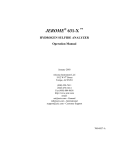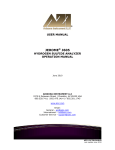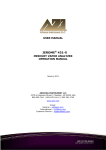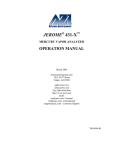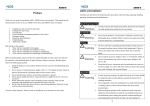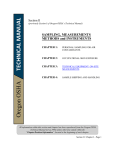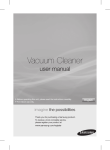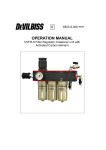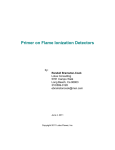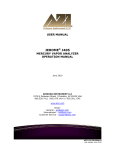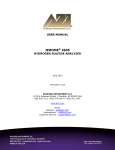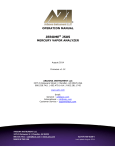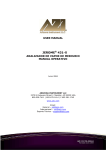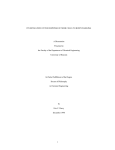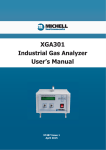Download Arizona Instruments Jerome 631 Hydrogen Sulfide Analyzer
Transcript
JEROME 631-X HYDROGEN SULFIDE ANALYZER Operation Manual July 1997 Arizona Instrument LLC 1912 W 4th Street Tempe, AZ 85281 (602) 470-1414 (800 )235-3360 Fax (602) 470-1888 http://www.azic.com email: [email protected] - General [email protected] - International [email protected] - Customer Support Part Number SS-087 Doc #6J21-0002, Rev B JEROME 631-X Hydrogen Sulfide Analyzer Operation Manual PROPRIETARY RIGHTS NOTICE This manual contains valuable information and material developed by Arizona Instrument LLC for use with the Jerome 631-X Hydrogen Sulfide Analyzer. No part of this manual can be reproduced or transmitted in any form or by any means, electronic, mechanical or otherwise. This includes photocopying and recording or in connection with any information storage or retrieval system without the express written permission of Arizona Instrument LLC. ALL RIGHTS RESERVED © Copyright 1997, Arizona Instrument LLC Resisorb™ is a registered trademark of J.T. Baker Chemical Company. Tygon™ is a registered trademark of Norton. iii iv TABLE OF CONTENTS FOR THOSE WHO CAN'T WAIT TO USE YOUR JEROME 631-X BEFORE READING THIS MANUAL . . . . . . . . . . . . . . . . . . . . . . . . . . . . . . . . . . . . . . . . . . . . . . . . . . . . . . vii 1 INTRODUCTION . . . . . . . . . . . . . . . . . . . . . . . . . . . . . . . . . . . . . . . . . . . . . . . . . . . . . . . 1 2 PRINCIPLE OF OPERATION . . . . . . . . . . . . . . . . . . . . . . . . . . . . . . . . . . . . . . . . . . . . . 2 3 INSTRUMENT OPERATION . . . . . . . . . . . . . . . . . . . . . . . . . . . . . . . . . . . . . . . . . . . . . 4 3.1 DIGITAL METER DISPLAY CODES . . . . . . . . . . . . . . . . . . . . . . . . . . . . . . . . . . . . . . 4 3.2 DAILY OPERATIONS . . . . . . . . . . . . . . . . . . . . . . . . . . . . . . . . . . . . . . . . . . . . . . . . 5 3.3 SENSOR REGENERATION PROCEDURE . . . . . . . . . . . . . . . . . . . . . . . . . . . . . . . . . . 6 3.4 SAMPLE MODE . . . . . . . . . . . . . . . . . . . . . . . . . . . . . . . . . . . . . . . . . . . . . . . . . . . . 7 3.5 SURVEY MODE . . . . . . . . . . . . . . . . . . . . . . . . . . . . . . . . . . . . . . . . . . . . . . . . . . . . 8 3.6 OPERATING ON AC POWER OR GENERATOR . . . . . . . . . . . . . . . . . . . . . . . . . . . . . 10 3.7 OPERATING ON INTERNAL BATTERY POWER . . . . . . . . . . . . . . . . . . . . . . . . . . . . 10 3.8 CHARGING BATTERIES . . . . . . . . . . . . . . . . . . . . . . . . . . . . . . . . . . . . . . . . . . . . . 10 3.9 OBTAINING MAXIMUM BATTERY LIFE . . . . . . . . . . . . . . . . . . . . . . . . . . . . . . . . . 11 4 MAINTENANCE . . . . . . . . . . . . . . . . . . . . . . . . . . . . . . . . . . . . . . . . . . . . . . . . . . . . . . 12 4.1 PREVENTIVE MAINTENANCE CALENDAR . . . . . . . . . . . . . . . . . . . . . . . . . . . . . . . 12 4.2 FLOW SYSTEM . . . . . . . . . . . . . . . . . . . . . . . . . . . . . . . . . . . . . . . . . . . . . . . . . . . 12 4.2.1 .25MM FRITWARE . . . . . . . . . . . . . . . . . . . . . . . . . . . . . . . . . . . . . . . . . . . . . . . . . 13 4.2.2 INTERNAL FILTERS . . . . . . . . . . . . . . . . . . . . . . . . . . . . . . . . . . . . . . . . . . . . . . . . 14 4.2.3 REPLACING BATTERY PACK . . . . . . . . . . . . . . . . . . . . . . . . . . . . . . . . . . . . . . . . . 14 5 INTERNAL DIP SWITCH SETTINGS . . . . . . . . . . . . . . . . . . . . . . . . . . . . . . . . . . . . . 16 5.1 SETTING THE INPUT VOLTAGE . . . . . . . . . . . . . . . . . . . . . . . . . . . . . . . . . . . . . . . 16 5.2 CHANGING THE FUSE . . . . . . . . . . . . . . . . . . . . . . . . . . . . . . . . . . . . . . . . . . . . . . 16 6 CALIBRATION . . . . . . . . . . . . . . . . . . . . . . . . . . . . . . . . . . . . . . . . . . . . . . . . . . . . . . . . 17 6.1 VERIFICATION OF CALIBRATION AND QUALITY CONTROL . . . . . . . . . . . . . . . . . . 17 7 631-X TROUBLESHOOTING . . . . . . . . . . . . . . . . . . . . . . . . . . . . . . . . . . . . . . . . . . . . 18 8 JEROME 631-X TECHNICAL SPECIFICATIONS . . . . . . . . . . . . . . . . . . . . . . . . . . . . 22 8.1 OPTIONAL “COMMUNICATIONS” VERSION . . . . . . . . . . . . . . . . . . . . . . . . . . . . . 23 8.2 INSTRUMENT I/O INTERFACE . . . . . . . . . . . . . . . . . . . . . . . . . . . . . . . . . . . . . . . . 23 9 ACCESSORIES & MAINTENANCE PARTS . . . . . . . . . . . . . . . . . . . . . . . . . . . . . . . . 25 9.1 631-X FLOW SYSTEM . . . . . . . . . . . . . . . . . . . . . . . . . . . . . . . . . . . . . . . . . . . . . . 26 9.2 REPLACEMENT PARTS . . . . . . . . . . . . . . . . . . . . . . . . . . . . . . . . . . . . . . . . . . . . . 26 v 10 MATERIAL SAFETY DATA SHEET . . . . . . . . . . . . . . . . . . . . . . . . . . . . . . . . . . . . . . 27 10.1 RESISORB . . . . . . . . . . . . . . . . . . . . . . . . . . . . . . . . . . . . . . . . . . . . . . . . . . . . . . . 27 10.2 NICKEL CADMIUM BATTERY . . . . . . . . . . . . . . . . . . . . . . . . . . . . . . . . . . . . . . . . 28 11 APPENDIX A - 631-X FUNCTIONAL TEST MODULE . . . . . . . . . . . . . . . . . . . . . . . 29 12 APPENDIX B - JEROME COMMUNICATIONS INTERFACE SOFTWARE . . . . . . 30 13 APPENDIX C - INTERNAL DIP SWITCH SETTINGS . . . . . . . . . . . . . . . . . . . . . . . . 32 14 APPENDIX D - JEROME 631-X OPTION BOARD . . . . . . . . . . . . . . . . . . . . . . . . . . . 33 14.1 DC POWER ADAPTOR KIT . . . . . . . . . . . . . . . . . . . . . . . . . . . . . . . . . . . . . . . . . . 33 14.2 AUTO-ZERO . . . . . . . . . . . . . . . . . . . . . . . . . . . . . . . . . . . . . . . . . . . . . . . . . . . . . 35 14.3 DC POWER OPERATION . . . . . . . . . . . . . . . . . . . . . . . . . . . . . . . . . . . . . . . . . . . . 35 14.4 TIMED REGENERATION . . . . . . . . . . . . . . . . . . . . . . . . . . . . . . . . . . . . . . . . . . . . 35 14.5 AUTO-SAMPLE . . . . . . . . . . . . . . . . . . . . . . . . . . . . . . . . . . . . . . . . . . . . . . . . . . . 36 14.6 4-20 MA ANALOG OUTPUT . . . . . . . . . . . . . . . . . . . . . . . . . . . . . . . . . . . . . . . . . 36 14.7 FRESH AIR SOLENOID . . . . . . . . . . . . . . . . . . . . . . . . . . . . . . . . . . . . . . . . . . . . . . 37 14.8 DC POWER MODE ENABLE . . . . . . . . . . . . . . . . . . . . . . . . . . . . . . . . . . . . . . . . . . 39 14.9 INSTRUMENT ZEROING . . . . . . . . . . . . . . . . . . . . . . . . . . . . . . . . . . . . . . . . . . . . . 39 15 APPENDIX E: CALCULATION/DYNACALIBRATOR H2S CONCENTRATION . . 41 16 WARRANTY . . . . . . . . . . . . . . . . . . . . . . . . . . . . . . . . . . . . . . . . . . . . . . . . . . . . . . . . . 42 vi FOR THOSE WHO CAN'T WAIT TO USE YOUR JEROME 631-X BEFORE READING THIS MANUAL Remember to read the manual for added details that will optimize the results and the life of your instrument. Also refer to the manual for complete details on operation, maintenance and troubleshooting, special voltage inputs or data output. The Jerome 631-X is easy to operate and ready for use upon receipt from the factory. Follow these brief steps to use your instrument: 1. Remove the instrument from the packing material. Check for any damage and confirm receipt of all parts on your packing list. Contact Arizona Instrument Customer Service at (800) 235-3360 or (602) 470-1414 if you have any questions. 2. Press the ON button. In less than one second the display should read .000. Note that a LO BATT message appears briefly in the upper left corner. (If the LO BATT light persists, it is necessary to charge the battery. See page 10 for details.) 3. Check the voltage setting (110 or 220 VAC) on the back of the instrument. Ensure that it is set to the correct voltage. (If the voltage must be changed, turn the knob. 4. Perform a sensor regeneration by following these steps: C Plug the line cord into the instrument using the plug in the back and to an AC power outlet. C Power the instrument ON and press the REGEN button. The instrument will begin a 10 minute regeneration cycle, indicated by .H.H.H flashing on the display. Do not interrupt this cycle. (For a complete description of this process, see page 6.) If any error message, such as .P.P.P or .L.L.L appears on the display, see the Troubleshooting section on page 18. C Adjust the sensor zero by pressing the ZERO button and turning the zero adjust screw located under the handle. Adjust until the display reads 0. 5. The instrument is now ready to sample. Note that as the instrument measures hydrogen sulfide, the ZERO will display H. Do not adjust the ZERO after the instrument has measured hydrogen sulfide and before the next regeneration. (Occasionally the ZERO may drop to L (for low) between the initial zeroing and the first sample. It is OK to readjust the ZERO if the instrument has not measured hydrogen sulfide.) 6. The instrument is designed for ambient air monitoring. Press the SAMPLE button to start a 10 second sampling cycle. DO NOT allow the probe or the instrument’s intake to come in contact with liquids. Note that the instrument is not explosion proof. 7. After the day’s survey, again perform a sensor regeneration. 8. Before each day’s use, once again perform a sensor regeneration and re-zero the instrument. Call AZI Customer Service, or your Technical Sales Representative, at (800) 235-3360 or (602) 470-1414 if you have any questions. vii THE JEROME 631-X HYDROGEN SULFIDE ANALYZER 1 INTRODUCTION The Jerome 631-X Hydrogen Sulfide Analyzer is designed for the easy and accurate analysis of hydrogen sulfide in the ambient air. The 631-X is easy to operate and has few maintenance requirements. However, please take a moment to read this manual before attempting operation. The Jerome 631-X is an ambient air analyzer with a range of 0.003 ppm to 50 ppm (parts per million). If you have any questions about your application or operation, please call AZI Customer Service at (800) 235-3360 or (602) 470-1414 for assistance. Features of the 631-X, include: C Automatic sensor regeneration when equipped with the communications option and used with the Jerome Communications Interface Software (JCI) program and the Jerome data logger. C Survey mode can be locked in. The Jerome 631-X can be operated from 100-120 or 200-240 VAC. To change the default voltage range, refer to Setting the Input Voltage, page 16. CAUTION: The Jerome 631-X is intended for vapor use only. DO NOT allow the probe or the instrument's intake to come in contact with liquids, dust or other foreign material. 1 2 PRINCIPLE OF OPERATION A thin gold film, in the presence of hydrogen sulfide, undergoes an increase in electrical resistance proportional to the mass of hydrogen sulfide in the sample. When the SAMPLE button is pressed, an internal pump pulls ambient air over the gold film sensor for a precise period of time. The sensor adsorbs and integrates the hydrogen sulfide and displays the measured concentration of detected hydrogen sulfide in ppm (parts per million). During normal sampling, the ambient air sample is diluted in the flow system at a ration of 100:1. When sampling in Range 0, (where low levels of hydrogen sulfide are expected) undiluted air samples are drawn across the gold film sensor. The instrument’s microprocessor automatically re-zeroes the digital meter at the start of each sample cycle and freezes the meter reading until the next sample cycle is activated, thus eliminating drift between samples. During the sample mode cycle, bars on the digital meter represent the percentage of sensor saturation. Depending on the concentrations, 50 to 500 samples may be taken before the sensor reaches saturation. At that point, a 10 minute heat cycle is manually activated to remove the accumulated hydrogen sulfide from the sensor. During the sensor regeneration cycle, both solenoids are closed, causing the air to pass through a scrubber filter to provide clean air for the regeneration process. The flow system’s final scrubber prevents contamination of the environment. The sensor may exhibit some low level thermal drift after the regeneration cycle, due to heat generated during the sensor regeneration. Wait 30 minutes after a sensor regeneration to ensure maximum sample accuracy. Gas Flow Schematics 2 3 3 INSTRUMENT OPERATION 3.1 DIGITAL METER DISPLAY CODES METER DISPLAY EXPLANATION 000 Ready to sample .000 No hydrogen sulfide reading .8.8.8 Sensor saturated-regeneration needed (refer to page 6) .H.H.H Sensor regeneration in progress (.H.H.H flashes) .L.L.L Re-zero needed (refer to page 6) .P.P.P Power cord required or low line power, <100 VAC (or 200 VAC) (see page 16, Changing the Fuse, if .P.P.P remains on after the cord is connected.) .LO BAT Recharge batteries (refer to page 10) .E.E.E Same as LO BAT, automatically shuts off .HL High level, sample exceeded range DURING SAMPLING .- 0-25% sensor saturation .-- 25-50% sensor saturation .--- 50-75% sensor saturation -.--- 75-100% sensor saturation DURING SAMPLING - USING THE SURVEY MODE Survey sampling (minus sign flashes continuously) WHEN ZERO IS DEPRESSED Adjust to 0 only after sensor regeneration. It is normal for the display to read H after sampling has started. 0 Zero, ready to sample H High, turn Zero pot counterclockwise L Low, turn Zero pot clockwise 4 3.2 DAILY OPERATIONS Before each day's use of the Jerome 631-X, perform the following steps to verify proper instrument operation: Procedure: C Press the power ON button. The digital meter displays 000. (Disregard the digital meter's initial momentary reading.) Recharge or replace the battery pack if the LO BAT indicator REMAINS ON. Refer to pages 10 and/or 14 for the procedure. To ensure the instrument's electronics have stabilized, allow a 1 minute warm up before beginning the next step. C Perform a sensor regeneration. Refer to page 6 for the procedure. Thirty minutes after sensor regeneration is complete, re-zero the instrument. NOTE: For maximum accuracy, such as when testing with the Functional Test Module, wait thirty minutes after the sensor regeneration cycle to rezero the unit. For immediate use the unit can be re-zeroed immediately after sensor regeneration C Press the SAMPLE button. During the sample cycle, the digital meter displays a bar (-) which indicates the amount of sensor saturation. C At the end of the sampling cycle, read the digital meter. The number shown on the digital meter is the hydrogen sulfide concentration in ppm. This value remains on the display until the next sample is taken. The digital meter automatically zeroes at the start of each sample. C At the end of each day's use perform a sensor regeneration. DO NOT ALLOW HYDROGEN SULFIDE TO STAY ON FILM OVERNIGHT. 5 3.3 SENSOR REGENERATION PROCEDURE A sensor regeneration is needed to clear the 631-X sensor of any accumulated hydrogen sulfide. This simple procedure should be done: C C C At the beginning of the day on which the instrument is to be used. During the hydrogen sulfide survey, if the sensor becomes saturated. At the end of the day’s survey, before storage. AC power must be between 100-120 VAC or 200-240 VAC, depending on the power source to clean and protect the sensor. CAUTION: Once a sensor regeneration is initiated, DO NOT interrupt the cycle. Procedure: C C C Attach the power cord to the 631-X and plug it into AC power. AC power is required to thermally regenerate the sensor. Press the power ON button. Press the REGEN button. The digital meter flashes .H.H.H for the duration of the 10 minute cycle and displays .0.0.0 when the cycle is completed. DO NOT INTERRUPT THIS CYCLE. Wait until the cycle is completed before continuing with the next step. NOTE: The digital meter will read .P.P.P after REGEN is activated if the power cord is not plugged in or if the instrument's fuse needs replacing. Plug in the power cord, or if necessary, replace the fuse according to the procedure on page 16. C While pressing the ZERO button, turn the ZERO ADJUST potentiometer using the trimmer tool until the digital meter reads 0. If the meter reads H, turn the ZERO ADJUST counter-clockwise; If the meter reads L, turn the ZERO ADJUST clockwise. See the illustration above for the location of the ZERO ADJUST potentiometer. 6 NOTE: A minimum 30 minute wait after the sensor regeneration cycle is complete ensures maximum sample accuracy. The unit can be used immediately following the sensor regeneration if necessary. When the sensor regeneration is complete, press ZERO and adjust the ZERO ADJUST pot until 0 appears on the display. Install the zero air filter in the intake and take several samples or lock the instrument into survey mode (see page 8). After approximately one minute, stop sampling and check the ZERO. Adjust to 0. Repeat sampling through the zero air filter until sensor remains on 0. NOTE: Depending upon internal configuration, a number between 00 and 100 may appear on the display, instead of H, L, or O when ZERO is pressed. See Internal Dip Switch Settings, page 32, for details. IMPORTANT: Do not turn the ZERO ADJUST potentiometer between samples. Turn the ZERO ADJUST only after a sensor regeneration cycle otherwise invalid readings will result. C C Press the power OFF button and disconnect the power cord. The Jerome 631-X is ready for sampling. 3.4 SAMPLE MODE This mode, used for standard operation, produces optimum accuracy with the Jerome 631-X. Range 0: Range 1: Range 2: Range 3: ± 0.003ppm at 0.050ppm H2S ± 0.03ppm at 0.50ppm H2S ± 0.3ppm at 5.0ppm H2S ± 2ppm at 25ppm H2S Procedure: C Press the power ON button. The digital meter displays 000. Disregard the digital meter's initial momentary readings. Recharge or replace the battery pack if the LO BAT indicator REMAINS ON. Refer to pages 10 and/or 14 for the procedure. To ensure the instrument's electronics have stabilized, allow a 1 minute warm up before beginning the next step. C Press the SAMPLE button. During the sampling cycle, the bar (or bars) shown on the digital display indicate the current percentage of sensor saturation. (Refer to Meter Display Codes, page 4, for code descriptions.) 7 C At the end of the sampling cycle, read the digital meter. The length of the sample cycle depends on the concentration of hydrogen sulfide. CONCENTRATION RESPONSE TIME 10 - 50 ppm 1.0 - 9.9 ppm 0.10 - 0.99 ppm 0.001 - 0 .099 ppm 13 seconds 16 seconds 25 seconds 30 seconds The number shown on the digital meter is the hydrogen sulfide concentration in ppm. As the instrument auto-ranges, the decimal point moves to the correct position to show the concentration. This value remains displayed until the next sample is taken. The digital meter automatically zeroes at the start of each sample. When the sensor is completely saturated, the digital meter displays .8.8.8 instead of a value. No further operation is possible until a sensor regeneration is performed. (Refer to page 6 for the Sensor Regeneration procedure.) C Press the power OFF button when not in use. SAMPLING NOTES: The Jerome 631-X operates a minimum of 6 hours on a fully charged battery. CAUTION: The Jerome 631-X is intended for vapor use only. DO NOT allow the probe or the instrument's intake to come in contact with liquids, dust or other foreign material. Moisture or liquids drawn into the instrument can damage the sensor and flow system. 3.5 SURVEY MODE The survey mode takes samples every 3 - 20 seconds automatically. Use this mode to locate the source of hydrogen sulfide, such as a leak or hot spot or to assess areas of potentially high hydrogen sulfide concentrations. After the survey mode is activated, the 631-X takes continuous samples. The length of time varies with the hydrogen sulfide concentration. Procedure: C Press the power ON button. The digital meter displays 000. (Disregard the digital meter's initial momentary readings.) Recharge or replace the battery pack if the LO BAT indicator REMAINS ON. Refer to pages 10 and/or 14 for the procedure. 8 To ensure the instrument's electronics have stabilized, allow a 1 minute warm-up before beginning the next step. C Press and hold the SAMPLE button. The instrument takes a normal sample, displays the concentration at the end of the cycle and then goes into the survey mode sampling every 3 - 20 seconds depending on the hydrogen sulfide concentration. The higher the concentration, the more frequently the instrument updates. As the instrument autoranges, the decimal point moves to the correct position to show the concentration. The display flashes the measured concentrations at the end of each sample cycle. C CONCENTRATION RESPONSE TIME 10 - 50 ppm 1.0 - 9.9 ppm 0.10 - 0.99 ppm 0.001 - 0.099 ppm 3 seconds 6 seconds 15 seconds 20 seconds When you are finished surveying, release the SAMPLE button. The final survey value remains displayed until the next sample is taken. NOTE: Approximately 100 samples may be taken before a sensor regeneration is required. C To lock the instrument in the survey mode, follow the first two steps. Hold the SAMPLE button down until the sensor status indicator bar(s) "_" begins flashing on the display. Press the ZERO button, then release the SAMPLE button. The pump should continue to run and the display should update every survey cycle. The instrument remains in the survey mode until one of the following occurs: - The sensor is saturated. - A LO BAT (low battery) signal is encountered. - An HL (high hydrogen sulfide level) is encountered. - The instrument is turned OFF to take it out of the survey mode. C Press the power OFF button when not in use. 9 3.6 OPERATING ON AC POWER OR GENERATOR For stationary use, the 631-X may be operated on AC power. Operating the instrument only on AC power eliminates the need for the battery pack and its necessary maintenance. If preferred, the battery may be unplugged or removed completely. When using a generator to power the Jerome 631-X, it is important that the generator is capable of maintaining a constant voltage output. This is especially true during the sensor regeneration. Use a high quality line conditioner or voltage regulator to prevent damage to the electronic components and the sensitive gold film sensor. 3.7 OPERATING ON INTERNAL BATTERY POWER Battery power allows use of the Jerome 631-X as a portable instrument. If battery power is necessary for use, please be aware of the following: C C C C C A fully charged battery pack (AZI P/N 2400-0907) provides power for a minimum of 6 hours of operation. For operating more than 6 hours, an extra fully charged battery pack is needed. Complete battery recharging takes 14 hours. Refer to page 10, Charging Batteries for the procedure. The 631-X uses a rechargeable NiCad battery. Dispose of properly when replaced. External battery power: A special version of the Jerome 631-X is available that can be operated from a secondary DC source, such as a battery used in conjunction with solar panels. Contact AZI for additional information. 3.8 CHARGING BATTERIES Procedure: C C Press the power OFF button. Attach the power cord to the 631-X and plug it into AC power. Complete battery recharging takes 14 hours. The 631-X contains a trickle charger so it may be continually plugged into an AC power source without damaging the battery pack. NOTE: To charge the batteries outside of the instrument, use the IDC Battery Charger (AZI P/N 4000-1011, for 115 VAC, P/N 4000-1012, for 230 VAC). 10 3.9 OBTAINING MAXIMUM BATTERY LIFE There are certain inherent limitations to NiCad (Nickel Cadmium) batteries. The primary limitation is a memory effect that occurs when the batteries are partially discharged and then recharged, repeatedly. This memory leads to a drastic reduction in the usable battery life. To prevent this memory effect, periodically allow the battery pack to discharge completely, then recharge the battery pack. For maximum battery life, follow these 3 steps: C C C At least once a month wait until LO BAT appears on the digital meter before recharging the battery pack. Charge the battery pack when the LO BAT indicator comes on. Excessive discharge can damage the battery pack. Before storing the instrument verify the power is OFF. When batteries fail to hold a charge, the battery pack should be replaced. Battery life under normal usage is approximately 1 year, depending on the number of charge and discharge cycles. 11 4 MAINTENANCE 4.1 PREVENTIVE MAINTENANCE CALENDAR To keep the Jerome 631-X operating at peak performance, follow the maintenance schedule below. Use this schedule as a guideline only, as maintenance is more a function of application and amount of use, rather than time. MAINTAINED PART/COMPONENT MAINTENANCE CYCLE REFER TO PAGE Charge batteries At least once per month, after 1 month's storage, or when LO BAT appears page 10 Change .25mm fritware Weekly or as needed page 13 Change internal filters and tubing After 6 months of use or as needed page 14 Replace zero air filter* Annually page 14 Factory calibration Every 6 months page 17 Calibration check Monthly or as needed Appendix A, page 29 Replace batteries Annually or as needed. The battery pack contains NiCad batteries. Dispose of properly. page 14 NOTE: Install the zero air filter into the instrument's intake during storage. * Zero air filters, LFS and LFD scrubber filters contain Resisorb™. For safety information, see the Material Safety Data Sheets included in this manual starting on page 27. Dispose of all filters properly. 4.2 FLOW SYSTEM The Jerome 631-X's flow system is the crucial link between the sensor and the sample. For the instrument to perform correctly, the flow system must be properly maintained. The user maintainable components of this system are the intake filter (.25 mm fritware), two scrubber filters and connecting tubing. 12 Check the Preventive Maintenance Calendar, page 12, for a suggested schedule for changing fritware and filters. The Tygon™ tubing in the system must be free of crimps for proper flow. 631-X Flow System Part # Part Z2600-3930 Z2600-3933 Z2600-3934 2600-3039 2500-3001 2500-3002 Scrubber Filter LFS Scrubber Filter LFD Scrubber Filter .25mm Fritware Tygon™ Tubing - 1/8" I.D. (1') Tygon™ Tubing - 1/16" I.D. (1') 4.2.1 .25MM FRITWARE Replace the .25mm fritware once a week. In dusty environments, the fritware may need replacement as often as once a day. Replacement .25mm fritware are available from AZI, Customer Service (see Accessories & Maintenance Parts, page 25). Procedure: C Unscrew and remove the intake from the Jerome 631-X. C Push the old fritware disc out using your trimmer tool. C Use tweezers to insert the new fritware. Avoid touching the new fritware disc with fingers. C Use the blunt end of the trimmer tool to seat the fritware disc firmly against the inner ledge of the intake. C Screw the intake back on the Jerome 631-X. CAUTION: The stem coming from the instrument onto which the outer intake housing is attached must be securely held in place. If loose, the tubing inside the instrument can become twisted when the intake housing is replaced. It may be necessary to open the instrument and tighten the hold-down nuts inside the instrument. Call AZI Customer Service with questions. 13 4.2.2 INTERNAL FILTERS Replace the internal filters after six (6) months of use, or as needed. (See Troubleshooting section, page 18.) Procedure: C Press the power OFF button and unplug the power cord. C Remove the 2 side screws from the intake end of the instrument and open the case. C Carefully disconnect the Tygon™ tubing from both ends of the filters and discard the old filters. CAUTION: Old filters, especially the scrubber filter may contain hydrogen sulfide. Scrubber filters contain Resisorb™. For safety information see the Material Safety Data Sheets on page 27. Use proper disposal methods. C Connect the new filters to the Tygon™ tubing, ensuring all filter nipples point toward the intake and elbows point according to the illustration. Push the Tygon™ as far as it will go onto the filter fittings. C Push the filters into the mounting clips. C Remove any crimps in the tubing and ensure that tubing connections are secure. C Close the case and replace the screws. C Dispose of all filters in accordance with state and federal regulations. 4.2.3 REPLACING BATTERY PACK Procedure: C Press the power OFF button. C Unplug the power cord. C Remove the 2 side screws from the intake end of the instrument and open the case lid. C Disconnect the battery connector from the board. C Loosen the 2 captive screws holding the battery bracket and remove the bracket. C Remove the old battery pack and replace with a new battery pack. 14 C C C C Replace the battery bracket and tighten the captive screws. Connect the new battery connector to the board. Close the case and replace the screws. Dispose of the old NiCad battery properly (in accordance with state and federal regulations). 15 5 INTERNAL DIP SWITCH SETTINGS 5.1 SETTING THE INPUT VOLTAGE This instrument has been factory set and calibrated to use the requested power setting (either 110 VAC or 220 VAC). The voltage setting is, however, easily changed to use either 110 VAC or 220 VAC. Procedure: C Ensure the instrument is turned OFF and unplugged. C Locate the power receptacle on the rear of the instrument. C Insert a small screwdriver in the voltage selection slot and turn the selector until the arrow points toward your setting choice and a click is heard. 5.2 CHANGING THE FUSE POWER RECEPTACLE VOLTAGE SELECTION SLOT FUSE COMPARTMENT SLOT If the instrument display reads .P.P.P when the instrument is connected to AC power or when REGEN is pressed, or if the battery will not charge, the fuse may need to be replaced. The AC line power could also be less than 100 VAC (220 VAC). Check the fuse or the AC line power with a voltage meter. Procedure: C Locate the power receptacle on the rear of the instrument. C Insert a small screwdriver in the slot (see figure above) and gently slide the fuse compartment out. C Remove and discard the fuse held in the open sided clip and replace it with the spare fuse held in the boxed spare fuse compartment. C Replace the fuse compartment in the power receptacle. C Replace the spare fuse with another 1A 250V Fast-Blo fuse (AZI P/N 51001012). 16 6 CALIBRATION The Jerome 631-X's gold film sensor is inherently stable and does not require frequent calibration. The interval between calibrations depends upon the application and frequency of use; however, the recommended interval is every 6 months. The Jerome 631-X has been factory calibrated using NIST traceable permeation tubes. These permeation tubes have a rated accuracy of +/- 2%. In order to calibrate the Jerome 631-X, a sophisticated calibration system is required that ensures stability of the calibration gas source, eliminates any pressure in the calibration gas stream and controls the temperature of the calibration environment. Calibration also requires special proprietary software. We strongly recommend you take advantage of our calibration and maintenance service at Arizona Instrument. Call Customer Service at (800) 235-3360 or (602) 470-1414 to arrange re-calibration. A certificate of calibration is issued from AZI when your instrument is factory calibrated. 6.1 VERIFICATION OF CALIBRATION AND QUALITY CONTROL The Functional Test Module (AZI p/n Z2600-0918) is used to determine if your instrument is within calibration tolerances between recommended semi-annual factory calibrations. It allows you to have complete confidence in the sample results. This test verifies proper instrument operation through the introduction of a known concentration of hydrogen sulfide into the Jerome analyzer. If your application requires frequent verification of instrument function, this test demonstrates the unit’s operation, calibration, and function. Recording Functional Test Module results in an instrument log provides a quality control/quality assurance record of instrument function between regular calibrations. If test results fall within the expected range, you may assume the instrument is functioning correctly. THIS TEST DOES NOT CALIBRATE THE INSTRUMENT. See page 29 in Appendix A, for complete Functional Test Module procedures. To order the module, contact your AZI Sales Representative at (800) 390-1414 or (602) 4701414. 17 7 631-X TROUBLESHOOTING Symptom Possible Cause Solution Unit does not turn ON. Unit turns on when power cord is plugged in. LCD displays 000 when connected to power cord and ON button is pressed. Dead battery. Recharge battery (minimum 14 hours), refer to page 10. Unit does not turn on when connected to AC power cord. Fuse. Replace fuse, refer to page 16. Insufficient power. Be sure there is power to the AC outlet using a volt meter. Internal component failure. Call AZI Customer Service for information. Power Problems Replace battery, refer to page 14. Regeneration & Zero Problems LCD displays .8.8.8. Sensor saturated. Do not attempt to rezero. Unit must be regenerated. See page 6 for information. LCD displays .L.L.L when taking first sample. Changes in temperature. Readjust zero pot. See page 6 for information. LCD displays H at finish of sensor regeneration when zero is pressed. Internal contamination may redeposit hydrogen sulfide from flow system onto gold film sensor. Remove and replace intake filter disk and Tygon™ tubing (see page 13). Check tubing for kinks or crimps. Repeat regeneration cycle. See page 6 for information. 18 Symptom Possible Cause Solution Zero adjust pot cannot be adjusted to 0. Pot not turned sufficiently. Turn zero adjust up to 20 times to reach the end. Pot will “click” softly. Display still unchanged. Sensor may be ruptured or pot may be broken. Turn pot slowly in opposite direction till display reads 0. If still unchanged, call AZI Customer Service at (800) 235-3360. Air flow is restricted during the sensor regeneration cycle, causing possible permanent damage. Kinks and crimps in the Tygon™ tubing. Periodically check the Tygon™ tubing inside the instrument (see page 13). High erratic results. Internal hydrogen sulfide contamination. 1. Install zero air filter in intake and tighten intake nut. Press SAMPLE button. After 3 samples, if readings are over 0.003 ppm, replace intake filters and Tygon tubing (see page 14). Sampling Problems 2. Perform a REGEN with zero air filter in intake. See page 6 for information. Retest if necessary. Replace intake filters and Tygon™ tubing (see page 14). 19 Symptom Possible Cause Solution High/erratic results Intake and internal filters may get clogged and need replacement when sampling in a dusty or humid area. Open instrument to check for pinched, crimped or disconnected internal tubing. In extreme conditions an additional particle filter may be installed on intake. High/erratic results Readings vary more than 0.003 ppm when in survey mode. Film connection. Press and hold SAMPLE button in clean area or with zero air filter in intake to lock in survey mode. Move the unit from side to side, or up and down during sample cycle. Low response or erratic readings after a long period of non-use. May need a second regeneration cycle. Wait 30 minutes between regeneration cycles. Test with FTM. See page 29 for information. If still unresponsive, call AZI Customer Service at (800) 235-3360. False readings, may go to .8.8.8 or .L.L.L. Extremely cold or extremely warm air sampled into unit. If sampling under these conditions, install zero air filter in intake. Sample until display reads 0.003 ppm or less. This equilibrates sensor temperature with the temperature of the sample air stream. Remove filter and take samples. 20 Symptom Possible Cause Solution Power cord not attached. Check power cord for connection Blown fuse. Replace fuse. See page 16 for information. Line voltage less than 100 VAC (or less than 200 VAC for 220 unit). Check line voltage settings. See page 16 for information. Cycles dipswitch set incorrectly. Check input cycle settings. See page 16 for information. Miscellaneous Problems Display reads .P.P.P when regeneration is attempted. If fuse and line voltage are OK, it may be circuit board adjustment or component, call AZI Customer Service for information. Display reads .E.E.E Very low battery. Recharge battery. See page 10 for information. Replace battery. See page 14 for information. . 21 8 JEROME 631-X TECHNICAL SPECIFICATIONS Range 0.003ppm (3ppb) to 50ppm H2S Sensitivity 0.003ppm H2S Precision 5% relative standard deviation Accuracy Range 0: Range 1: Range 2: Range 3: ± 0.003ppm at 0.050ppm H2S ± 0.03ppm at 0.50ppm H2S ± 0.3ppm at 5.0ppm H2S ± 2ppm at 25ppm H2S Response time-sample mode 10 to 50 ppm 1.0 to 9.9 ppm 0.10 to 0.99 ppm 0.001 to 0.099 ppm 13 seconds 16 seconds 25 seconds 30 seconds Response time-survey mode 10 to 50 ppm 1.0 to 9.9 ppm 0.10 to 0.99 ppm 0.001 to 0.099 ppm 3 seconds 6 seconds 15 seconds 20 seconds Flow rate 150cc/min (0.15 liters/min) Power requirements 115 VAC (or 230 VAC) 115 watts maximum Batteries Rechargeable Nickel Cadmium Fuse 1A 250V 5 X 20 Fast Blo Construction Aluminum alloy Dimensions 15 cm x 33 cm x 10 cm (6" w x 13" l x 4" h) Weight 3.18 kilos (7 pounds) Digital meter Liquid crystal display (LCD) Operating environment 0E - 40EC, non-condensing, non-explosive 22 8.1 OPTIONAL “COMMUNICATIONS” VERSION Alarm output 30V DC, 100mA Data output 1. Digital, Serial, RS232, Baud Rate 1200 for use with Data Logger, and/or JCI program software. 2. Digital, Serial, RS232 data format, but with driver for 20mA capability and 0 & 20mA logic levels; Baud Rate 1200 (special industrial applications). "OPTION BOARD" - See page 33. Data output 0 - 2V or 4 - 20 mA Auto sample interval 5, 15, 30, 60 minutes Auto regeneration interval 6, 24 or 72 hours 8.2 INSTRUMENT I/O INTERFACE The 631-X I/0 port (25 pin D-sub) has six functions: C Serial communication channel, RS-232 Interface type: RS-232C full duplex, DCE Communication parameters - 1200 Baud, 1 start bit, 8 data bits, 2 stop bits, no parity Pin assignments: Pin 1 Protective ground Pin 2 Data in Pin 3 Data out Pin 7 Data ground C Serial communication channel, 20mA current loop Interface type: 20mA current loop, full duplex Communication parameters - 1200 Baud, 1 start bit, 8 data bits, 2 stop bits, no parity Pin assignments: Pin 1 Protective ground Pin 4 Data out (+) Pin 5 Data in (+) Pin 14 Data out (-) Pin 16 Data in (-) 23 C Alarm output Maximum voltage Maximum current Pin assignments: Pin 9 Pin 10 Pin 7 Pin 23 30 VDC 100mAmp Switched battery+ Alarm output (open collector, active low) Battery ground Battery ground C Switched battery connection for data logger Pin assignments: Pin 9 Battery + Pin 7 Battery ground Pin 23 Battery ground C Unswitched battery connection for external battery pack pin assignments Pin assignments: Pin 15 Battery + Pin 19 Battery + Pin 7 Battery ground Pin 23 Battery ground NOTE: Pins 6, 8, 11, 17, 18, 20 and 21 are non-standard and should not be connected. 24 9 ACCESSORIES & MAINTENANCE PARTS PART # ITEM DESCRIPTION Y631-0901 631 Accessory Kit Includes: zero air filter (1), .25mm fritware (20), trimmer tool (1), probe (1), tubing adapter (1) Z2600-0918 631 Functional Test Module Includes: 1/8 x 3/16 reducer (1), tubing adapter (1), Allen wrench (1), 1 foot of 1/8" I.D. Tygon tubing, 1 foot if 3/16" I.D. Tygon tubing, filter cap (1), 1 pound desiccant, guide pins - (2), 115 VAC line cord (1), Permeation tube assembly (1), Functional Test Module Operation Manual (1) Y631-0903 631 Maintenance Kit Includes: .25 mm fritware (60), 021 battery pack (1), LFS scrubber filter (1), LFD scrubber filter (1), 1 foot Tygon™ tubing - 1/8" I.D. (1') & Tygon™ tubing - 1/16" I.D. (2') Y6100-0057 JCI Data Logger Y6100-0054 JCI Software Kit Y411-0904 031/411 Carrying Case Assembly Includes: case & die cut foam rubber Holds: Jerome 631-X, personal hydrogen sulfide & accessories 1400-0052 001 Field Carrying Case Assembly 25 9.1 631-X FLOW SYSTEM Z2600-3933 Z2600-3934 Z2600-3930 Z2600-3905 1400-3010 1400-3009 PS-151 2600-3039 2500-3001 2500-3002 LFS scrubber filter LFD scrubber filter Scrubber filter Zero air filter Tubing adapter Intake Nozzle Tube Nut .25mm fritware Tygon™ tubing - 1/8" I.D. (1 foot) Tygon™ tubing - 1/16" I.D. (1 foot) 9.2 REPLACEMENT PARTS Z4000-0907 Z2600-3905 1400-3010 4000-1011 4000-1012 1300-0025 2300-0001 6000-4003 5100-1012 6100-1055 021 Battery pack assembly Zero air filter Tubing adapter IDC battery charger - 115 VAC IDC battery charger - 230 VAC 1/8" - 1/16" Tubing Adapter Trimmer tool Line Cord Spare Fuse Interface (I/O) Cable For current prices and delivery information, call AZI Customer Service at (800) 2353360 or (602) 470-1414. FACTORY CALIBRATION SERVICE Service includes filter replacement, component check and calibration and instrument calibration to NIST traceable standards. For authorization & scheduling, call AZI Customer Service at (800) 235-3360 or (602) 470-1414. 26 10 MATERIAL SAFETY DATA SHEET Date of Issue 04/95 10.1 RESISORB J.T. Baker Chemical Company ARIZONA INSTRUMENT LLC 1912 W 4th Street Tempe, AZ 85281 INFORMATION HOTLINE (800) 235-3360 Product Identification: PRODUCT NAME: Resisorb - Hydrogen Sulfide absorbent FORMULA CAS NO.: 00000-00-0 MOLECULAR WEIGHT: 0.00 CHEMICAL FORMULA: Proprietary mixture Section 1 - Physical Data APPEARANCE & ODOR: Black solid with halogenlike odor BOILING POINT: N/A MELTING POINT: N/A VAPOR PRESSURE: N/A SPECIFIC GRAVITY: N/A Section 2 - Fire and Explosion Hazard Data FIRE: Combustible, keep away from heat, sparks, flame. EXPLOSION: Contact with strong oxidizers may cause explosion. FIRE HAZARD: Use water spray to soak, class A extinguisher, gull protective clothing & NIOSH approved self-contained breathing apparatus, move exposed containers from fire area if it can be done without risk, if not, use water to keep fire-exposed containers cool. Section 3 - Reactivity Data STABILITY: Stable, no hazardous polymerization CONDITIONS TO AVOID: Heat, flame, sources of ignition INCOMPATIBILITIES: Strong oxidizing agents, nitric acid, ammonia, alkali metals, strong reducing agents Section 4 - Leak/Spill Disposal Information PRODUCT CLEAN-UP: Protective clothing & respiratory protection, scoop up spilled material, avoid dusting, flush spill area with water. DISPOSAL: Transfer to clean, dry container & dispose of in accordance with local, state & federal environmental regulations. Section 5 - Health Hazard Information EXPOSURE/HEALTH EFFECTS: INHALATION: May cause tightness & chest pain, coughing & difficulty in breathing. INGESTION: May cause nausea, vomiting, headaches. SKIN AND EYES: Dust may irritate skin and/or eyes. FIRST AID: INGESTION: get medical attention, if conscious, immediately induce vomiting. SKIN AND EYES: Immediately flush with water for 15 minute minimum; remove contaminated clothing. Section 6 - Special Protection Information Use adequate general or local ventilation to keep fume or dust levels as low as possible. If airborne concentration is high, use respirator or dust mask. Wear rubber gloves & eye protection. Section 7 - Storage and Special Information Keep in tightly closed container, in cool, dry ventilated area, away from heat, sparks or flame; isolate from incompatible substances. The information and recommendations set forth herein are presented in good faith and believed to be correct as of the date hereof. Arizona Instrument LLC, however, makes no representations as to the completeness or accuracy thereof and information is supplied upon the condition that the persons receiving same will make their own determination as to its suitability for their purposes prior to use. In no event will Arizona Instrument LLC be responsible for damages of any nature whatsoever resulting from the use of or reliance upon this information. 27 MATERIAL SAFETY DATA SHEET Section 5 - Health Hazard Information 10.2 NICKEL CADMIUM BATTERY MATSUSHITA BATTERY INDUSTRIAL CO 1 Matsushita-Cho Moriguchi Osaka 570 JAPAN EMERGENCY TELEPHONE 201-392-6703 INFORMATION TELEPHONE 714-373-7538 Product Identification: PRODUCT NAME: Nickel Cadmium Battery HAZARDOUS INGREDIENTS: Ni(OH)2, NiOOH, Cd, Cd(OH)2, KOH or NaOH, LiOH CHEMICAL FORMULA: NiCd Section 1 - Physical Data APPEARANCE & ODOR: None BOILING POINT: Approximately 170EC MELTING POINT: N/A VAPOR PRESSURE: N/A SPECIFIC GRAVITY: 2.6 Section 2 - Fire and Explosion Data FIRE HAZARD: Under normal charging and discharging, no fire hazard exists. EXPLOSION: Under normal charging and discharging, no explosion hazard exists. Section 3 - Reactivity Data STABILITY: Extremely stable INCOMPATIBILITIES: N/A Section 4 - Leak/Spill Disposal Information PRODUCT CLEAN-UP: Non-toxic in normal use DISPOSAL METHOD: DO NOT incinerate. Dispose of in discharged state to avoid shorting. 28 EXPOSURE/HEALTH EFFECTS: INHALATION: N/A INGESTION: N/A SKIN AND EYES: May irritate if contact is made with the electrolyte (alkaline). FIRST AID: INHALATION: N/A INGESTION: N/A SKIN AND EYES: Immediately flush affected area with cool water. If contact is made with the eyes or mucous membranes, immediately flush with water and get medical assistance. Section 6 - Special Protection Information No special protection required in normal usage. Section 7 - Storing and Special Information No special precautions required for storing. The information and recommendations set forth herein are presented in good faith and believed to be correct as of the date hereof. Arizona Instrument LLC, however, makes no representations as to the completeness or accuracy thereof and information is supplied upon the condition that the persons receiving same will make their own determination as to its suitability for their purposes prior to use. In no event will Arizona Instrument LLC be responsible for damages of any nature whatsoever resulting from the use of or reliance upon this information. 11 APPENDIX A - 631-X FUNCTIONAL TEST MODULE The Jerome Hydrogen Sulfide Functional Test Module provides a fast and easy method of verifying that Jerome 631-X Hydrogen Sulfide Analyzers are within specifications. The Functional Test Module is beneficial: C C C C in applications where frequent verification of functionality is required, such as ISO 9000 documentation; to verify proper instrument operation when unexpected readings are obtained in normal sampling; as part of a weekly maintenance routine; and to determine if analyzer calibration is needed. Simple Operation The Functional Test Module includes a permeation tube containing hydrogen sulfide. When activated the test module releases this H2S from the permeation tube at a specific, known concentration. The H2S flows over the gold film sensor of the Jerome analyzer, which then measures the amount of exposure to the gas. The flow rate and temperature of this release are factory set to provide a concentration of approximately 250 ppb (0.250 ppm) ± 20%. The user then compares the reading on the Jerome analyzer with the known concentration of the release from the module. If the H2S level shown on the analyzer’s display falls within the expected range (approximately 250 ppb), the instrument is functioning properly. If the level is not in the expected range, it should be returned to the factory for NIST-traceable calibration. Hydrogen Sulfide Functional Test Module Components The following components are included with the H2S Functional Test Module: C C C C C C C C C C C 1/8 x 3/16 Reducer (p/n 1300-0031) Tubing adapter (p/n 1400-3010 Allen wrench (p/n 2300-0003 1 foot of 1/8" I.D. Tygon tubing (p/n 2500-3001 1 foot if 3/16" I.D. Tygon tubing (p/n 2500-3001) Filter cap (p/n 2600-3010) 1 pound desiccant (p/n 2600-3055) Guide pins - 2 (p/n 2800-2044) 115 VAC line cord (p/n 6000-4003) Permeation tube assembly (p/n Z2600-3939) Functional Test Module Operation Manual (p/n SS-112) The Functional Test Module carries a limited one-year warranty to be free from defects or workmanship, except for the permeation tube, which is warranted for 90 days. Refer to the operation manual for complete warranty information. 29 12 APPENDIX B - JEROME COMMUNICATIONS INTERFACE SOFTWARE The Jerome Communications Interface Software (JCI) is used with 631-X Hydrogen Sulfide Analyzers that feature the Communications Configuration option. C The JCI software allows the user to program the instrument for unattended monitoring and to down-load recorded data stored in the Jerome Data Logger. C Automatic sampling can be initiated every one (1) to sixty (60) minutes with programmable audible alarm levels. INSTRUMENT CONTROL WITH REAL-TIME GRAPHICS When connected to a Jerome 631-X analyzer, the software collects and graphs data as it is being received and performs statistical analysis. To provide maximum resolution, the graph is “auto-scaling” in both time (hours, days or weeks) and concentration. Alarm levels can be set by the user. Alarms trigger an audible buzzer at the computer and activate a relay on the instrument for remote indicators, such as a light or fan. The JCI software is menu-driven and easy to use. Each display screen is designed for clarity with self-explanatory menu options. Select menu options using the arrow keys and the “Enter” key. Jerome Communications Interface Program [Main] Operate Instrument Display Stored Data Program/Read Data Logger Configure Exit Program 89=Move * 5=Select * <ESC>=Exit Menu 30 The user creates records, or files, for computer storage of collected data. Data is easily retrieved for later viewing, graphing, printing, editing with spreadsheet or word processing software (not provided). Data can be used for ongoing record keeping or for fulfilling local regulatory requirements. JCI KIT CONTENTS C One 5 1/4" and one 3 ½" disk containing the JCI software C Instrument-Data Logger-PC Interface cable (AZI p/n #6000-1056) C User’s manual SYSTEM REQUIREMENTS C Instrument: Jerome 631-X with the Communications Option. These Jerome instruments have a 25 pin- “D” connector and related internal hardware and “firmware.” C Computer: IBM (or compatible) PC, XT, AT, 286, 386, 486 or Pentium C Operating System: MSDOS or PCDOS 2.1 or higher C Video: CGA, EGA or Hercules-compatible monochrome (VGA operates as EGA). Install MSHERC.COM (provided) before using Hercules monochrome. C Memory: 512 K bytes or larger C Interface: Serial interface card C Printer: IBM, Epson or HP Laserjet Series II graphics compatible The software can run off the program floppy or off the computer’s hard drive. Before using the software, familiarization with the Jerome Hydrogen Sulfide Analyzer and user’s manual is important. DATA LOGGER OPTION The software can also program the Jerome Data Logger (AZI p/n 61000010) used with the Jerome analyzer. The computer programs the data logger which then attaches to the instrument. The data logger initiates automatic sampling, triggers alarms and stores data. This optional accessory enables portable automatic sampling without a dedicated computer. O DATA LOGGER 31 13 APPENDIX C - INTERNAL DIP SWITCH SETTINGS The DIP switch is located at the top, center of the circuit board (SW2). SW2 NOTE: Switch instrument power OFF before changing DIP switch settings. DIP Switch Settings: 32 1 ON AUTORANGE DISABLED (SEE DIP SWITCHES 5 & 6) 1 OFF AUTORANGE ENABLED 2 X NOT USED 3 X NOT USED 4 ON ZERO DISPLAY: 00-99 4 OFF ZERO DISPLAY: L-O-H 5 6 RANGE SAMPLE TIME ON ON 0 (.000 - .099PPM) 14 SECONDS ON OFF 1 (0.10 - 0.99 PPM) 20 SECONDS OFF ON 2 (01.0 - 09.9 PPM) 14 SECONDS OFF OFF 3 (10 - 50 PPM) 13 SECONDS 14 APPENDIX D - JEROME 631-X OPTION BOARD Proper use of this board assumes that the base instrument is set correctly for the intended operation. Please refer to the main instrument manual for that information. S101 NOTE: IF R101 IS MOVED FROM THE FACTORY SET POSITION, CALL CUSTOMER SERVICE AT (800) 235-3360 OR (602) 470-1414. R101 SW100 SW101 14.1 DC Power Adaptor Kit The DC power adaptor kit consists of an interface board and a specially modified DC to AC power inverter. This kit works with AZI/Jerome instruments with installed option boards. The combination of the option board and DC power adaptor kit allows operation, including sensor regeneration, from 12 volt battery systems. INSTALLATION: C Ensure that the instrument’s option board switches are set correctly. Especially note that the option board’s dip switch (SW100) #6 must be set to “ON” for DC operation. C Mount the interface board to the rear of the instrument. Tighten the mounting screws. C Place or mount the DC/AC power inverter in a secure position near the instrument. C Connect the cable from the DC/AC power inverter to the matching connecter on the interface board. Note that the connectors are keyed to prevent improper connection. C Plug the instrument’s AC power cord into the power inverter and connect it to the instrument. C NOTE that the inverter’s power switch is in the “OFF” position. LEAVE the power switch in the “OFF” position at all times. The interface board will activate the inverter when necessary. If the inverter power switch is placed in the “ON” position, it will cause a continuous drain on the external 12 volt power system. C Remove the rear cover of the inverter by first removing the two screws at the rear top of the inverter, then sliding the cover sideways and away from the inverter. 33 C Connect cables from the external 12 volt power source to the appropriate (NEG and POS) terminals on the back of the inverter. It is suggested that the provided cable restraints be used. C Reinstall the cover. If the external 12 volt lines are not powered, power them now. C Turn the instrument “ON.” C Press the “REGEN” switch on the instrument. Inverter operation can be verified in either of two ways: a. Immediately after pressing “REGEN” the inverter will intermittently “sing.” This tone slowly becomes nearly continuous and then ends after 64 seconds. If the area is noisy, use the following method: b. Use a volt meter or test lamp to verify that approximately 115 volts is present for about 64 seconds, starting when the “REGEN” switch is pressed. C Allow the instrument to complete its regeneration before turning it off. C With the instrument turned off, complete the installation (i.e. connect data logger, communications cables, or other devices and ensure that the instrument, option board and dip switches are correctly set. USER SUPPLIED CABLES TO JEROME 431X/631X NOTE: KEEP SWITCH IN "OFF" POSITION. WITH COMMUNICATION CAPABILITIES POWER INVERTER DC POWER INTERFACE BOARD AZI p//n 10000094 AC POWER CABLE NOTE CONNECTOR IS KEYED. POWER INVERTER INTERFACE CABLE A DATALOGGER OR OTHER DEVICE CAN BE MOUNTED TO REAR CONNECTOR. 34 AZI p/n 6000-1093 14.2 AUTO-ZERO With the option board installed, the 631-X has a limited auto-zero function. This function cannot be disabled and is transparent to the user. The instrument can be manually zeroed as described on page 6. However, if the instrument is to be operated by personnel not familiar with the procedure or if it is operated unattended, the auto-zero function should satisfactorily zero the unit after each sensor regeneration. 14.3 DC POWER OPERATION The 631-X may be operated from almost any +12VDC source if the option board and a Power Inverter Kit are installed. (Refer to the Power Inverter Kit Operating Instructions for details.) To work with the Power Inverter Kit, place SW100 dip switch 6 to the ON position. 14.4 TIMED REGENERATION If the unit is to be operated unattended for extended periods, AZI recommends that the sensor be regenerated regularly. While operation under JCI or data logger control automatically regenerates saturated sensors. Regeneration will not occur as shown when sample streams have a very low concentration of H2S. The option board controls regeneration on a regular basis, every 6, 24 or 72 hours. The regeneration intervals are set through a combination of switch settings as shown in the following table: ------- SW100--------- REGENERATION Switch #1 Switch #2 Interval (Hrs.) OFF OFF OFF ON OFF 6 OFF ON 24 ON ON 72 35 14.5 AUTO-SAMPLE If a data logger is connected and operating in the manual sampling mode, or a data logger is not connected, the following automatic sampling rates may be selected with SW100 dip switch settings: Dip switch settings Sampling frequency 3 4 4 ON ON ON No automatic sampling OFF ON ON 5 minutes OFF OFF ON 15 minutes OFF ON OFF 30 minutes OFF OFF OFF 1 hour This auto-sample function will not function if a data logger is connected and operating in automatic sampler mode programmed through the JCI. 14.6 4-20 MA ANALOG OUTPUT The analog output signal at pin 18 of the 25 pin connector can be configured to provide the instrument's native mode 0-2 Volt output or the optional 4-20 mA output by setting the option board jumper (SW101) to the "V" position for voltage, or the "I" position for current. (Pin 23 is the ground pin for the analog output function. Pin 18 is positive with respect to the ground pin). C C The 0-2 Volt output circuit can drive loads of 10 k ohms or higher. The 4-20 mA output is a passive transmitter and requires the connected receiver to supply between 10 and 28 volts of excitation potential. Note that neither analog output circuit is floating. Both circuits' negative terminals are connected to the instrument's common ground buss. SW101 Functions: 36 V= 0-2V analog output I= 4-20 ma analog output Figure 1 Figure 2 Figure 3 Jerome 631-X instruments shipped after early 1995, are capable of providing 0-2 volts analog output. Instruments shipped before that time can be upgraded by a firmware update and adjustment. Instruments that are capable of 0-2 volt output can be upgraded to 4-20 mA output with the addition of an option board upgrade. This must be installed at the factory. CONNECTION AND SETUP: C C C C C 14.7 0-2 volt devices connect as shown in Figure 1. If the instrument includes an option board, be sure its analog jumper (SW101) is set to the “V” position. 4-20 mA active receivers connect as shown in Figure 2. Note that an active receiver contains a voltage source to power the loop current. Note that the receiver must have an isolated input circuit. That is, it must not be connected to ground or to a voltage source referenced to ground. Be sure that SW101 is set to the “I” position before power is applied. 4-20 mA passive receivers do not contain a voltage source to power the loop current. They require the addition of a separate isolated power supply. Typically a supply that delivers 15 to 20 volts DC at 50 mA is sufficient. Wire these as in Figure 3. Note that some 12 volt DC wall transformers (as used on portable equipment) may deliver 15 to 20 volts when they are lightly loaded. The CUI/Stack #AD-1220M is a commonly available example of a 12 volt 200mA supply that will deliver around 18 volts nominal when loaded below 20 mA. Be sure that the power supply used, and the passive receiver are both floating. If either is not floating, the circuit will not work and damage may occur. Ensure that SW101 is set to the “I” position before power-up. FRESH AIR SOLENOID An external three way solenoid can be used to provide an alternate source of fresh air to the instrument during regeneration. This may be necessary if the sample stream lacks molecular oxygen. A low current six volt DC solenoid, connected between pins 19 and 11 of the 25 pin rear panel connector, will be energized during the regeneration cycle if the option board SW100 switch 6 is placed in the OFF position. 37 SW100 Switch Functions: Switch Function 1 Regeneration enable and time 2 Regeneration enable and time 3 Auto sample enable 4 Auto sample time 5 Auto sample time 6 D.C. Power mode enable. Application Note The following sample handling hardware, external to the Jerome instrument can be used to provide fresh air or conditioned air during sensor regeneration. This configuration should only be needed in the case of oxygen depleted sample streams. Note that to support this external hardware, the Jerome 631-X must have the option board assembly installed at the factory. 1/8" TUBE 1/16" TUBE 1/16" TUBE TO SAMPLE SOURCE TO INSTRUMENT 1/16" TUBE TO FRESH AIR SOURCE PIN 1 REAR OF CONNECTOR, CONNECT TO PINS 11 AND 19 MOST INSTRUMENTS 38 PIN 1 REAR OF CONNECTOR, CONNECT TO PINS 19 AND 21 631-X SHIPPED IN 1994 ONLY Required Parts: Suggested Part Similar AZI P/N 1 six volt three way solenoid 1/8" to 1/16" tubing adaptor 1/2" clamp, adhesive mount 1/8" tube to instrument adaptor Angar P/N 407569 Any Any Make 1300-1004 1300-0025 6000-0013 1400-3010 3" 1/8" tubing A/R 1/16" tubing 1 25 pin male DB-25 connector Solder-cup style 1 connector hood Tygon Formula R3603 Tygon Formula R3603 AMP 747912-2 2500-3001 2500-3002 None * AMP 749626-2 None * * These are types not stocked by AZI, but should be available overnight from many AMP stocking distributors such as Digi-Key Corporation. There are multiple suitable alternatives such as Radio Shack’s 276-1547 and 276-1549. 14.8 DC POWER MODE ENABLE Instruments with the 631-X option board modification can be used with any +12 VDC source for continuous operation, if the AZI DC-AC power inverter kit is installed. The instrument requires 115 volts AC for regeneration. To preserve the life of the DC power source, the DC-AC inverter is switched on automatically for the regeneration only. The external switch on the inverter should always be OFF to preserve battery life during normal sampling. When the instrument starts a regeneration and when DIP #6 is ON, the instrument sends a signal to close the relay on the 631-X data logger interface board mounted between the data logger and the instrument. This switches the inverter ON using the inverter’s internal switch. NOTE: When this mode is enabled, the instrument does NOT check for 115 VAC for the regeneration. If there is no AC power to the instrument, and a regeneration is initiated, the instrument will flash .H.H.H (rather than .P.P.P), however the sensor will not heat, nor will the sensor clean. 14.9 INSTRUMENT ZEROING The Jerome 631-X has essentially three zeros at the option board configuration: C The instrument automatically rezeroes between samples and each sample is a unique reading. To take a sample, simply press the SAMPLE button. C The zero on the membrane switch is used to re-establish a baseline between the reference and sensor gold film after a sensor regeneration. This zero is manually adjusted by pressing the ZERO button and turning the potentiometer on the top of the instrument until the display reads 0. Adjust only after sensor regeneration; it is normal for H to be displayed after sampling. C The 631-X option board provides an auto-zero feature following regeneration that is invisible to the user. In some cases, the instrument cannot resume sampling after a regeneration. .L.L.L appears on the display when the ZERO button is pressed and the error message “manual bridge adjust needed” is added to the notes column of the JCI text file when the JCI software is used. If this problem persists, it may be necessary to re-set the auto-zero. 39 When necessary to re-adjust the auto zero point: C Turn instrument off. C Note original DIP switch settings on option board. C On option board, turn DIP switch 4 on red DIP box to ON. C Set the switches on the option board’s blue DIP box to 1,2,6 OFF; 3,4,5 ON. C Turn the instrument ON. C Switch option board DIP #1 OFF and ON three times, leaving it ON. C While pressing the ZERO button, turn the potentiometer on the option board until the numbers increase (maximum of 20). Note the display will flicker one digit. C Return all switches to original position. NOTE: The higher the auto-zero number, the lower the sensor capacity and the more sensor regenerations are needed. 40 15 APPENDIX E: CALCULATION OF DYNACALIBRATOR H2S CONCENTRATION UNIT DEFINITIONS mole / 6.02@1023 molecules ngm ' gm 109 PPMv / 10-6 CALCULATIONS (molar volume @ 25EC) ( (tube permeation rate) (molecular weight of H2S) (total gas flow rate) ' PPMvolume/volume Ltr mole ngm @(5090@ ) gm min 34.07@ mole ' 0.512@PPMv mL 7138@ min 24.45@ Mole units divide out, as do mass units, leaving volume per minute in both the numberator and the denominator. This leaves a unitless quantity scaled by 1 x 106 in the denominator which is the definition of PPM. 41 16 WARRANTY Arizona Instrument LLC (seller) warrants to buyer that Jerome products delivered pursuant to this Agreement shall, at the time of delivery, and for a period of one (1) year thereafter (the Internal Battery Pack, where applicable, is warranteed for a period of ninety [90] days only), be free from defects in material or workmanship and shall conform to seller's specifications or such other specifications as seller has agreed to in writing. Seller's obligations with respect to claims under this warranty shall be limited, at seller's option, either to the replacement of defective or nonconforming product or to an appropriate credit for the purchase price thereof subject to the provisions of seller's Warranty Policy as amended from time to time, said Policy being incorporated herein by reference. Returned products under warranty claims will be shipped to seller’s plant by buyer at buyer's expense and shall be accompanied by a statement of the reason for the return and an approved Return Material Authorization Number issued by seller. Buyer remains responsible for payment for products not accepted for warranty adjustment and freight and handling costs associated therewith. Notwithstanding the foregoing, no warranty shall be enforceable in the event that product has been subjected to environmental or stress testing by buyer or any third party without written approval of seller prior to such testing. Further, no warranty shall be enforceable if the alleged defect is found to have occurred as a result of misuse, neglect, improper installation, repair, alteration, accident, or improper return handling procedure by buyer. Discontinued product is warranteed only for a credit or replacement at seller's option. THE EXPRESS WARRANTIES GRANTED ABOVE SHALL EXTEND DIRECTLY TO BUYER AND NOT TO BUYER'S CUSTOMERS, AGENTS, OR REPRESENTATIVES AND, EXCEPT FOR WARRANTY OF TITLE, IS IN LIEU OF ALL OTHER WARRANTIES, WHETHER EXPRESSED OR IMPLIED, INCLUDING ANY IMPLIED WARRANTIES OF FITNESS FOR A PARTICULAR PURPOSE AND MERCHANTABILITY, SUCH OTHER WARRANTIES BEING SPECIFICALLY DISCLAIMED BY SELLER. IN NO EVENT SHALL EITHER PARTY'S LIABILITY FOR ANY BREACH OR ALLEGED BREACH OF THIS AGREEMENT EXCEED THE TOTAL EXTENDED PRICE OR PRICES SHOWN ON UNFILLED ORDERS, NOR SHALL EITHER PARTY BE LIABLE FOR ANY SPECIAL, INCIDENTAL OR CONSEQUENTIAL DAMAGES RESULTING FROM BREACH OR ALLEGED BREACH. Notwithstanding the foregoing, if any product covered by order(s) placed hereunder is designated as “developmental,” “prototype” or “experimental,” no warranty whatsoever except a warranty of title to component materials, will be applicable thereto and buyer shall indemnify seller for any claims for liability asserted seller in connection therewith. The foregoing state the entire liability of seller in connection with products supplied hereunder. 42 TRADEMARK AND COPYRIGHT PROTECTION Jerome Instrument, Arizona Instrument, AZI and the stylized AZI are all registered trademarks of Arizona Instrument LLC. Copyright 1990-1997, Arizona Instrument LLC. All Rights Reserved. Resisorb™ is a registered trademark of J.T. Baker Chemical Company Tygon™ is a registered trademark of Norton. Arizona Instrument LLC Jerome 631-X Hydrogen Sulfide Analyzer Operation Manual Part Number SS-087 Revision B July 1997 If you have any questions regarding the operation of this instrument, please call our toll free number (800) 235-3360. Internationally, call (602) 470-1414 or fax (602) 470-1888. Arizona Instrument LLC 1912 W 4th Street Tempe, Arizona 85281 USA http://www.azic.com email: [email protected] - General [email protected] - International [email protected] - Customer Support 43




















































